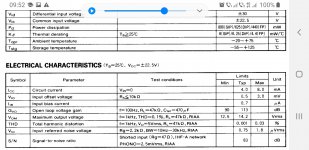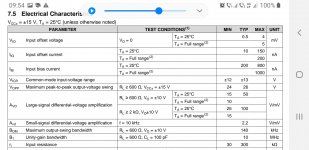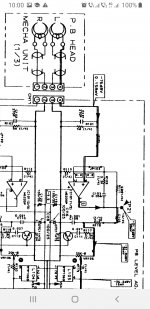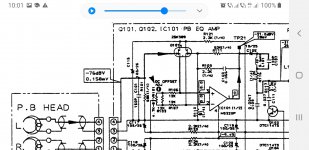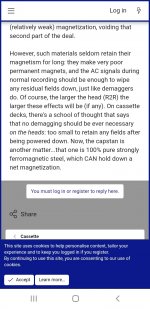Really? Is ne5532 so bad?...My Pioneers and Sony used m5220 chips for decades without magnetizing anything...and their offset and bias currents aren't very different from ne5532...Pioneer ct 979 and ct777 have identical heads.The difference is in the loading which takes into account the higher resistive loading of bipolar input and the higher capacitance loading in the jfet input , but the output of the heads are the same.Maybe in 40 years of continuous use a head would magnetise from that current, but that tapehead won't last 40 years of continuous use anyway.
Attachments
Last edited:
The 5532 is good compared to the opamps of its time. Hell it is a still livving legend.
Magnetisation isnt a overtime process. And it usually happens during power up and down because the power supply( both negative and positive) just cannot power up at the same instant time so it sends a large DC current trough the inputs.
The approach on the readably rotated schematic is the correct one. My Fostex G24S uses a very similar approach to it aswell.
The Revox A700 heads have a much higher impedance than any cassette head, so even small current will DC magnetise the heads. Other heads might be less susceptible to this, but overtime excessive noise will develop on the tape as you play it. Hooking an opamp of the NE5532 caliber straight to repro heads is a nono. You can do it with TL072 062 082 or any CMOS/JFET input opamp (like I mentioned OPA1656) but not BJT.
Magnetisation isnt a overtime process. And it usually happens during power up and down because the power supply( both negative and positive) just cannot power up at the same instant time so it sends a large DC current trough the inputs.
The approach on the readably rotated schematic is the correct one. My Fostex G24S uses a very similar approach to it aswell.
The Revox A700 heads have a much higher impedance than any cassette head, so even small current will DC magnetise the heads. Other heads might be less susceptible to this, but overtime excessive noise will develop on the tape as you play it. Hooking an opamp of the NE5532 caliber straight to repro heads is a nono. You can do it with TL072 062 082 or any CMOS/JFET input opamp (like I mentioned OPA1656) but not BJT.
Tl072 is noisier than ne5532 for a cassette tapehead kind of signal and impedance although it doesn't really matter.
As for the magnetisation myths...
http://www.ant-audio.co.uk/Tape_Recording/Heads_/Sandwich_heads_measured.htm
As for the magnetisation myths...
http://www.ant-audio.co.uk/Tape_Recording/Heads_/Sandwich_heads_measured.htm
Attachments
The statement is wrong. Its not the size that matters. The DC fields dont happen on the poles only but they are most intensive in the pas where recording and playback happens. If you think this does not matter you really should test for yourself.
Most cassette decks have the luxury of using universal heads where magnetised heads will get demagged by bias. This isnt the case wothseparate R/Pheads.
And if you think head impedance doesnt matter? Damn youre so wrong. A higher impedance head will yeald a higher repro voltage from the same flux, a lower head impedance would allow you to drive the head with a lower voltage during record. This defines the functionality of the heads and also how they act.
Higher impedance specialised playback heads are far easier to magnetise with smaller currents due to lower currents inducing higher fluxitivity.
If you think hooking the noninverting input of a NE5532 directly to the head is adequate, be my guest, but that has so much wrong with it.
The TL071 has a higher noise figure, all thogh inexoerience its still lower than that of a CrO2 cassette by some miracle. I never had a chance to test metal cassettes because I dont have the money to buy such overpriced media.
The best solution is to have the head feeding a Jfet like the 2SK170(modern day equivalently great would be JFE150) set it for 10x gain and then use a NE5532 / 5534 to do the rest of the ampliffication and EQ. This is the approach most if nit almost every manufacturer went that wanted opamps in the front.
The Fostex G24S I own has this exact approach, with a not so great opamp. And the discrete head preamps unless it isnt quite complex will not outperform the opamp solution. And when the discrete complicated circuit does outperform the opamp Jfet solution, its at 10x the price of the easy solution.
Today we have opamps much better fit for positions like that of a head preamplifier.
OPA1656 is just one of them that is also budget friendly. The JFE150 Jfets are also budget friendly, and you can make a composite amplifier with a Jfet and an opamp of any sort givving you the most freedom.
Most cassette decks have the luxury of using universal heads where magnetised heads will get demagged by bias. This isnt the case wothseparate R/Pheads.
And if you think head impedance doesnt matter? Damn youre so wrong. A higher impedance head will yeald a higher repro voltage from the same flux, a lower head impedance would allow you to drive the head with a lower voltage during record. This defines the functionality of the heads and also how they act.
Higher impedance specialised playback heads are far easier to magnetise with smaller currents due to lower currents inducing higher fluxitivity.
If you think hooking the noninverting input of a NE5532 directly to the head is adequate, be my guest, but that has so much wrong with it.
The TL071 has a higher noise figure, all thogh inexoerience its still lower than that of a CrO2 cassette by some miracle. I never had a chance to test metal cassettes because I dont have the money to buy such overpriced media.
The best solution is to have the head feeding a Jfet like the 2SK170(modern day equivalently great would be JFE150) set it for 10x gain and then use a NE5532 / 5534 to do the rest of the ampliffication and EQ. This is the approach most if nit almost every manufacturer went that wanted opamps in the front.
The Fostex G24S I own has this exact approach, with a not so great opamp. And the discrete head preamps unless it isnt quite complex will not outperform the opamp solution. And when the discrete complicated circuit does outperform the opamp Jfet solution, its at 10x the price of the easy solution.
Today we have opamps much better fit for positions like that of a head preamplifier.
OPA1656 is just one of them that is also budget friendly. The JFE150 Jfets are also budget friendly, and you can make a composite amplifier with a Jfet and an opamp of any sort givving you the most freedom.
@techtool
Yep. Thats the head preamp you can make when your opamp has 45nA input bias current.
Ps that circuit has a 50us TC. Bout right for NAB 7 1/2ips or 15ips and 19cm/s DIN home reel to reel standard
To correct my typo in the previous post, the poles being magnetised is not the biggest deal, the gap though, small almost irrelenvant flux leaking from the head poles themselves arent the concern, the magnetisation happens in the gap more speciffically at the trailing edge of the head. The more you play the tape the more it becomes plagued by DC noise.
If the entire magnetic circuit was tk be magnetised in the axis such a way so that both poles at the face would be the same polarity, not much noise would actually be induced, but the coil magnetises the core specificcally so the gap has a concentrated DC flux.
Yep. Thats the head preamp you can make when your opamp has 45nA input bias current.
Ps that circuit has a 50us TC. Bout right for NAB 7 1/2ips or 15ips and 19cm/s DIN home reel to reel standard
To correct my typo in the previous post, the poles being magnetised is not the biggest deal, the gap though, small almost irrelenvant flux leaking from the head poles themselves arent the concern, the magnetisation happens in the gap more speciffically at the trailing edge of the head. The more you play the tape the more it becomes plagued by DC noise.
If the entire magnetic circuit was tk be magnetised in the axis such a way so that both poles at the face would be the same polarity, not much noise would actually be induced, but the coil magnetises the core specificcally so the gap has a concentrated DC flux.
So, can't you just use the LT1028 and change the R-C values to get the TC you need?Yep. Thats the head preamp you can make when your opamp has 45nA input bias current.
Ps that circuit has a 50us TC. Bout right for NAB 7 1/2ips or 15ips and 19cm/s DIN home reel to reel standard
At that point why not go full ham with a compound amplifier consisting of a JFE150 and a OPA1612? from the datasheet specs and graphs seems its an even better performer than the more as 3times as expensive LT1028.
This would get you insanely low on the machine noisefloor. Your tape is still gonna do at best 70dB anyways
This would get you insanely low on the machine noisefloor. Your tape is still gonna do at best 70dB anyways
This is what I was talking about. One hell of a psychotic comination. Comes out to be 7dollars just for the jfet and opamp, which seems cheap, and it is, when youre building two channels. (I just had a thought where a 32channel studio machine would have these for each channel and sync heads...thats 64 separate circuits. That would be 500dollars for a 32 channel machine..)
Everything before C1 is a simulation of my heads so you can ignore that. It doesnt show in the gain graph.
the command step parameter is there to change the value of R5 changing the timeconstant - eq for different tape speeds.
Green = 76.2cm/s
Blue= 38.1cm/s
Red= 19.05cm/s
Tyrk.= 9.53cm/s(included just for the fun of it)
You willl need calibration tapes for the respective speeds. That includes 9,53cm/s. The tolerance of C4 can and will largely throw off the TC value. 5% of tolerance if too much. Even if you measure the resistor very precisely you have to deal with the cappacitor tolerance and if you manage to achieve the TC you need via external measurements (dB drop over frequency trough and external measuring meathod) and have the correct TC values, you still need to compensate the head losses. Head loss part is much less of a concern, but if you tune that out of the picture aswell, you willl have the best possible setup within rasonable price..Other more expensive solutions might be little better, but a 500% price increase gets you a 5% improvement over this- in otherwords- more expensive Jfets and opamps dont make any sense whatsoever.
The feedack loop is designed with IEC1 and AES2 standards in mind - no lower TC
19,05cm/s = 70us
38,1cm/s = 35us
76.2cm/s = 17,5us
Calculating TC values for cassette heads is also possible. You will need to add a lower TC though (3180us bass rolloff)
- Home
- Source & Line
- Analogue Source
- Magnetic tape head voltage output
